高教版中职英语基础模块.docx
- 格式:docx
- 大小:39.42 KB
- 文档页数:6

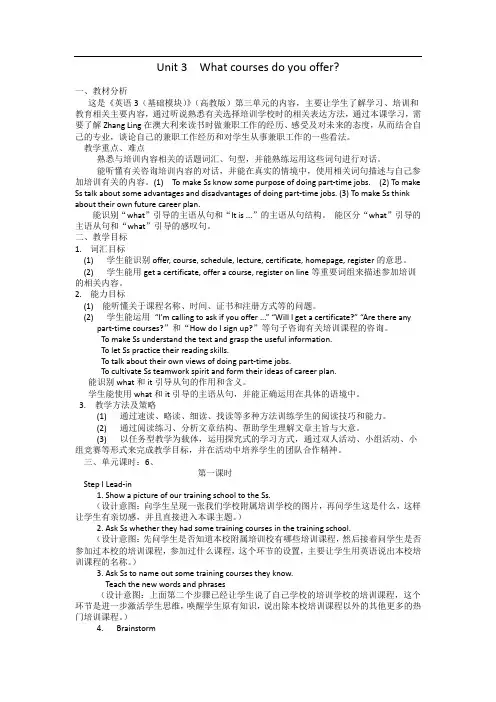
Unit 3 What courses do you offer?一、教材分析这是《英语3(基础模块)》(高教版)第三单元的内容,主要让学生了解学习、培训和教育相关主要内容,通过听说熟悉有关选择培训学校时的相关表达方法,通过本课学习,需要了解Zhang Ling在澳大利来读书时做兼职工作的经历、感受及对未来的态度,从而结合自己的专业,谈论自己的兼职工作经历和对学生从事兼职工作的一些看法。
教学重点、难点熟悉与培训内容相关的话题词汇、句型,并能熟练运用这些词句进行对话。
能听懂有关咨询培训内容的对话,并能在真实的情境中,使用相关词句描述与自己参加培训有关的内容。
(1) To make Ss know some purpose of doing part-time jobs. (2) To make Ss talk about some advantages and disadvantages of doing part-time jobs. (3) To make Ss think about their own future career plan.能识别“what”引导的主语从句和“It is ...”的主语从句结构。
能区分“what”引导的主语从句和“what”引导的感叹句。
二、教学目标1. 词汇目标(1) 学生能识别offer, course, schedule, lecture, certificate, homepage, register的意思。
(2) 学生能用get a certificate, offer a course, register on line等重要词组来描述参加培训的相关内容。
2. 能力目标(1) 能听懂关于课程名称、时间、证书和注册方式等的问题。
(2) 学生能运用“I’m calling to ask if you offer ...” “Will I get a certificate?” “Are there anypart-time courses?”和“How do I sign up?”等句子咨询有关培训课程的咨询。
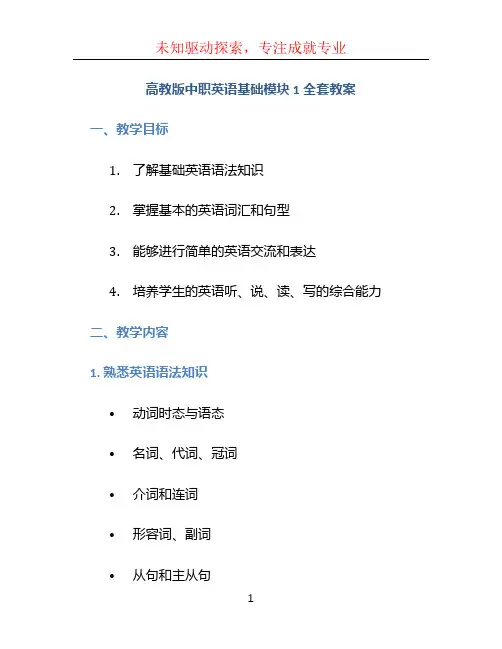
高教版中职英语基础模块1全套教案一、教学目标1.了解基础英语语法知识2.掌握基本的英语词汇和句型3.能够进行简单的英语交流和表达4.培养学生的英语听、说、读、写的综合能力二、教学内容1. 熟悉英语语法知识•动词时态与语态•名词、代词、冠词•介词和连词•形容词、副词•从句和主从句2. 学习基本英语词汇和句型•基本的日常用语•常用的交际用语•简单的口语表达3. 提高英语听、说、读、写的能力•听力训练•口语练习•阅读理解•写作练习三、教学方法1.多媒体辅助教学:利用多媒体设备展示相关教学内容,使学生更加直观地理解和记忆。
2.分组合作学习:鼓励学生在小组中进行交流和合作,提高学生的英语口语表达和听力理解能力。
3.角色扮演:通过角色扮演的方式,让学生在模拟真实情境中用英语进行交流,提高学生的口语表达能力。
四、教学步骤第一课时:动词时态与语态1.导入:通过展示图片或视频,引发学生对动词时态与语态的思考和讨论。
2.教学内容:–简要讲解动词时态的概念和用法–介绍常用的动词时态,如一般现在时、一般过去时、一般将来时等–解释动词语态的概念和用法,包括主动语态和被动语态3.学习活动:–提供一些例句,让学生判断所给动词的时态和语态–练习填空,要求学生根据所给的句子空格填写正确的动词时态和语态–分组讨论,让学生互相提问和回答关于动词时态和语态的问题4.总结归纳:总结动词时态和语态的用法,并给出相应的规则和例子。
第二课时:名词、代词、冠词1.导入:通过展示图片或给出句子,引发学生对名词、代词和冠词的注意和讨论。
2.教学内容:–讲解名词的基本概念和用法,包括单数形式和复数形式的变化规则–简要介绍代词的种类和用法,如人称代词、物主代词、反身代词等–解释冠词的用法和区别,如定冠词和不定冠词的使用场景3.学习活动:–提供一些句子,让学生根据句中的名词、代词和冠词来确定其词性和用法–练习填空,要求学生根据所给的句子空格填写适当的名词、代词和冠词–分组讨论,让学生分享各自在名词、代词和冠词使用方面遇到的问题,并互相解答4.总结归纳:总结名词、代词和冠词的基本用法,并给出相应的例子和规则。
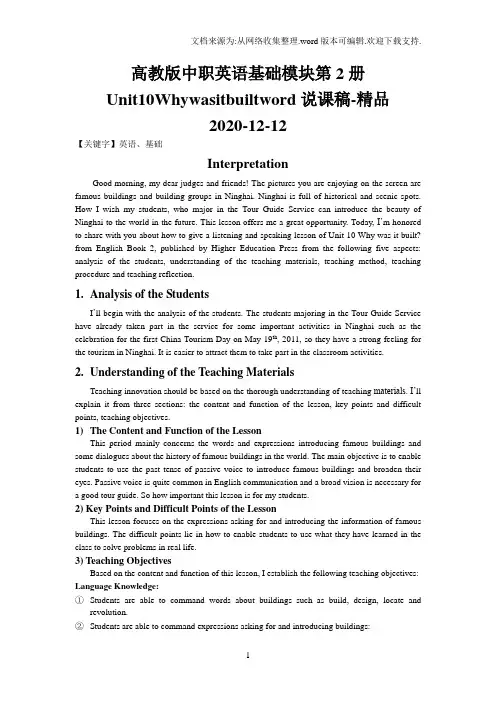
高教版中职英语基础模块第2册Unit10Whywasitbuiltword说课稿-精品2020-12-12【关键字】英语、基础InterpretationGood morning, my dear judges and friends! The pictures you are enjoying on the screen are famous buildings and building groups in Ninghai. Ninghai is full of historical and scenic spots. How I wish my students, who major in the Tour Guide Service can introduce the beauty of Ninghai to the world in the future. This lesson offers me a great opportunity. Today, I’m honored to share with you about how to give a listening and speaking lesson of Unit 10 Why was it built? from English Book 2, published by Higher Education Press from the following five aspects: analysis of the students, understanding of the teaching materials, teaching method, teaching procedure and teaching reflection.1.Analysis of the StudentsI’ll begin with the analysis of the students. The students majoring in the Tour Guide Service have already taken part in the service for some important activities in Ninghai such as the celebration for the first China Tourism Day on May 19th, 2011, so they have a strong feeling for the tourism in Ninghai. It is easier to attract them to take part in the classroom activities.2.Understanding of the Teaching MaterialsTeaching innovation should be based on the thorough understanding of teaching materials. I’ll explain it from three sections: the content and function of the lesson, key points and difficult points, teaching objectives.1)The Content and Function of the LessonThis period mainly concerns the words and expressions introducing famous buildings and some dialogues about the history of famous buildings in the world. The main objective is to enable students to use the past tense of passive voice to introduce famous buildings and broaden their eyes. Passive voice is quite common in English communication and a broad vision is necessary fora good tour guide. So how important this lesson is for my students.2) Key Points and Difficult Points of the LessonThis lesson focuses on the expressions asking for and introducing the information of famous buildings. The difficult points lie in how to enable students to use what they have learned in the class to solve problems in real life.3) Teaching ObjectivesBased on the content and function of this lesson, I establish the following teaching objectives: Language Knowledge:①Students are able to command words about buildings such as build, design, locate andrevolution.②Students are able to command expressions asking for and introducing buildings:When was it built? It was built in/on…Why was it built? It was built to …Who design ed it? It was designed by…What was it used for? It was used for…Language Skills:①Students are able to predict before listening and listen for detailed information by catching thekey words to understand the dialogues talking about the famous buildings②Students are able to talk about the famous buildings with each other by using the key wordsand expressionsCultural Awareness: Students are able to get familiar with the history of some famous western buildings.Affection:①Students are able to broaden their eyes by getting familiar with some famous buildings in theworld and love their own hometown by introducing its famous buildings.②Students are able to cooperate with others by selectively putting the materials together tomake an introduction of one famous building.3.Teaching MethodsTo achieve the above teaching objectives, situational teaching method and task-based language teaching method are adopted in this class.4.Teaching ProceduresT eaching procedures are the most important of a successful teaching. Before class, apart from making a multi-media courseware and Question-Answer cards which will be used in the speaking activity, I’ll divide the students into groups of 6 according to their language ability. As for the students, they need to collect materials about famous buildings in Ninghai (such as pictures, videos, the location and so on). With everything prepared, here come the six teaching steps:Step 1: Lead-inI will play the video showing famous buildings in Ninghai one minute before class to help students begin their English learning in a relaxing atmosphere.With the help of the video, I smoothly begin the class by talking about the tourism in Ninghai to activate students’ background knowledge and preset a task for the students: it is your honorable duty to introduce the famous buildings in Ninghai to the world. And all the following activities are to help them prepare for this duty.First of all, broaden their eyes. A matching competition will be held between groups and details about the buildings will be introduced later by showing more pictures and asking them the following questions: Where is it? Why was it built? to lead in the study of key expressions. Group cooperation can relieve students’ fear caused by the unfamiliarity with the English expressions of these famous buildings while group competition can fully motivate their learning enthusiasm. Step 2: ListeningThe students may know a lot about one famous building, but how to introduce it to tourists? I will introduce the magical blanket of Aladdin to link different teaching steps and change the whole boring listening process into a wonderful traveling to enjoy famous buildings in the world and experience how to guide a tourist to visit famous buildings at the same time. This is the pointwhere I integrate the teaching materials and set an interesting situation for students.Students are certainly eager to begin their traveling, but which buildings are we going to visit? They will listen to three tour guides introducing the three buildings and order the pictures. This step serves as preparation for the following activities by briefly introducing the background knowledge of three buildings, which follows the study law-from the easy to the difficult.Then we will arrive in the first stop of our wonderful travel-the Statue of Liberty. I’ll ask the students: If you are the tour guide, what questions do you think the tourists will ask? Do you know the answers? With their own predictions in mind, a flash will be followed to check the answers by circling the questions they hear and completing the fact file. In the above process, students are not passively asked to do some meaningless listening activities. Instead, they actively explore for the information through different listening strategies directed by different questions and experience the use of key expressions. The information technology makes it possible to let students play an initiative role in a vivid learning environment.Step 3: SpeakingThe Statue of Liberty is a gift from the French people, so in the following step, I’ll lead students to France to visit the Eiffel Tower. Students need to win the passports for themselves by helping the magical blanket finish the Question-Answer cards. They will read aloud after the tape, underline the questions about the information of buildings to put into the Question card of a tourist and then find the answers to put into the Information card of a tour guide. The listening activities act as a role of implicit learning, and then this activity is to cultivate students’ ability to summarize and help students command the key expressions in an explicit way.After receiving enough input, now it’s time for the students to output. I will lead them to visit the Eiffel Tower by showing a flash to let students understand how to use Question-Answer cards to act out a dialogue. After that, we will be in the last stop of our wonderful travel. It’s students’turn to guide me to visit the Great Wall. A video showing its beautiful scenery will be played and students need to act out a dialogue by using the provided Question-Answer Cards. By role playing, students become the masters of the class while the teacher is a helper who offers the information cards. They are given the opportunity to speak out and practice the key expressions again.Step 4: TaskEnsuring that the students have enough language foundation after a series of listening and speaking activities, the preset task at the beginning of the class is presented to them. They need to work in groups and finish the following tasks:First, share the materials they have collected with their group members and choose a famous building they all like.Then discuss with each other about the building and put together the materials to make an introduction of it.(Possible questions to think about: What was the building used for? When was it built? Who designed? Why was it built? Why is it famous? Is there any interesting stories about it...)At last, each group should choose a representative to show the result to the whole class and then the whole class chooses the best tour guide according to the following standards:The standards not only act as guidance for the students to work out the group task during the discussion, but also attract the attention of the whole class during the show time.The highlight of this step is creating a language situation closely related with their major by making full use of local characteristics. And this is what I do to break through the difficult points of this lesson.Step Five Self-checkThe following step is self-check. It presents the key contents of this lesson to deepen students’ impression and also helps the teacher to check whether the targeted teaching objectives are reached or not. What’s more, it offers two different levels for students to choose from, which can meet the different needs of students in different language levels.Step Six HomeworkAfter class, students need to work in groups again and choose a famous building in Activity1. Collect as much information about it as possible by searching the Internet. Make full use of what they have learned in the class to make an oral presentation in the next class.5.Teaching ReflectionAs teachers, we should always help students study more efficiently and get ready for their future study or future jobs. In this class, all the teaching activities are carefully designed to meet students’real needs and help students develop their overall language ability by playing an initiative role in a situation close to the real life and future career. And the information technology shows its great advantage in breaking through the key and difficult points of this lesson. It provides sounds, pictures and visual images such as flashes and videos to make it possible to let students intuitively experience the language used in scenes which they are unfamiliar with such as visiting the Statue of Liberty and Eiffel Tower.youtAt last, I’d like to show the layout as follows:Self-check Sheet。

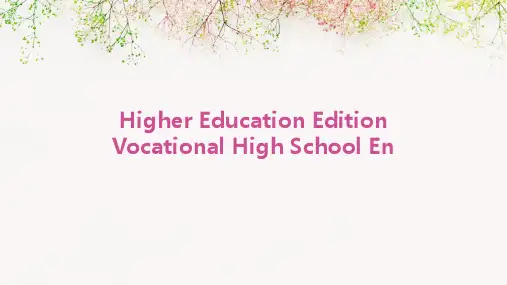
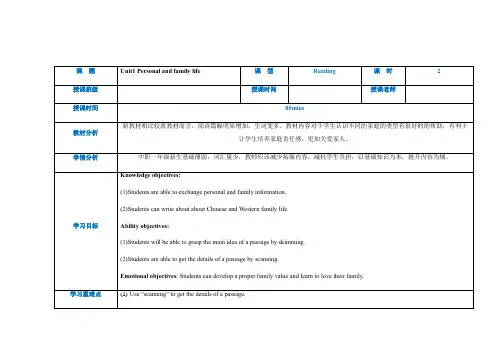
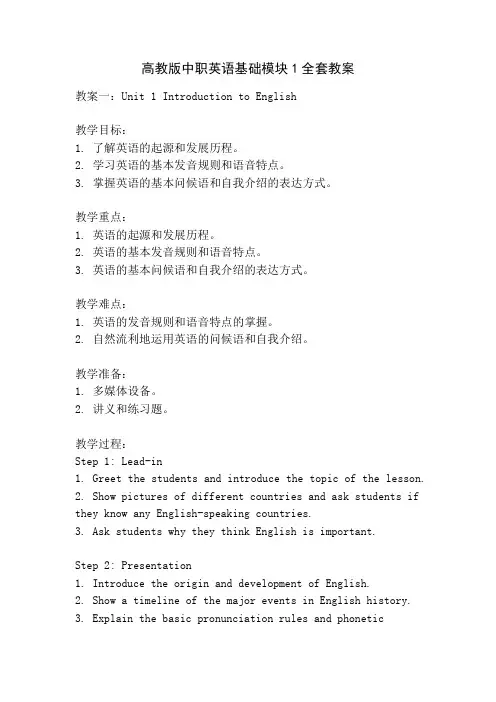
高教版中职英语基础模块1全套教案教案一:Unit 1 Introduction to English教学目标:1. 了解英语的起源和发展历程。
2. 学习英语的基本发音规则和语音特点。
3. 掌握英语的基本问候语和自我介绍的表达方式。
教学重点:1. 英语的起源和发展历程。
2. 英语的基本发音规则和语音特点。
3. 英语的基本问候语和自我介绍的表达方式。
教学难点:1. 英语的发音规则和语音特点的掌握。
2. 自然流利地运用英语的问候语和自我介绍。
教学准备:1. 多媒体设备。
2. 讲义和练习题。
教学过程:Step 1: Lead-in1. Greet the students and introduce the topic of the lesson.2. Show pictures of different countries and ask students if they know any English-speaking countries.3. Ask students why they think English is important.Step 2: Presentation1. Introduce the origin and development of English.2. Show a timeline of the major events in English history.3. Explain the basic pronunciation rules and phoneticfeatures of English.4. Use audio or video materials to demonstrate the correct pronunciation.Step 3: Practice1. Divide the class into pairs or small groups.2. Give students a list of common greetings and ask them to practice using them in different situations.3. Have students practice introducing themselves to each other using the phrases and sentences learned.Step 4: Consolidation1. Review the key points of the lesson, including theorigin and development of English, pronunciation rules, and greetings.2. Ask students to summarize what they have learned intheir own words.Step 5: Assessment1. Give students a short quiz to test their understanding of the lesson.2. Assign homework, such as writing a short paragraph about the importance of English or practicing greetings and self-introductions.教案二:Unit 2 Numbers and Time教学目标:1. 学习基本的数字和时间表达方式。
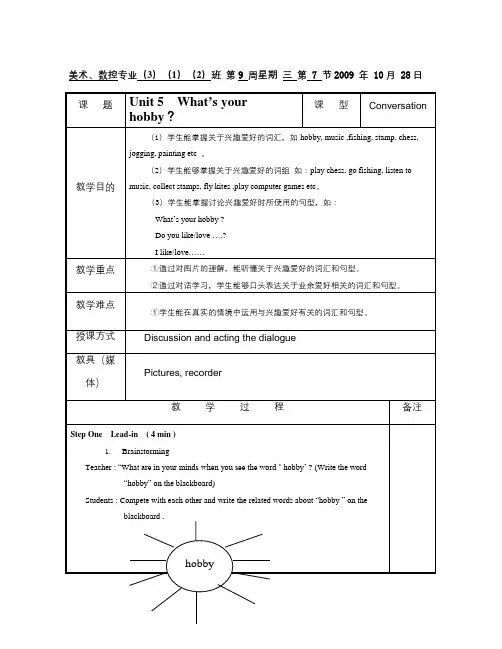
美术、数控专业(3)(1)(2)班第9 周星期三第 7 节2009 年 10月 28日(设计意图: 激活学生已有的词汇知识。
通过词汇比赛启发学生的主动思维,调动学生的积极性、主动性,也为后面的听说做好最基础的词汇铺垫。
)Step Two Word Study (10 min)1.Matching game (Activity 1 )Teacher : Show the words and related pictures of different hobbies on the screen.Students: Work in pairs and match the words to make phrases as the example.2.Listen and check (Activity 2 )Listen to the tape and check the answers in Activity 1.3.Listen and complete (Activity 3)Listen to the tape again and complete the sentences under each picture to talk abouthobbies.(设计意图: 动词和名词的配对活动,以及将词汇学习与具体的图片相结合,帮助学生以较为生动的形式学习词汇。
并通过听力和完成句子的书面活动让学生在听、写方面巩固词汇。
)Step Three Listening (15min)1.Pre-listeningTeacher: Ask several students about their own hobbies. The dialogue as follows :T: What’s your hobby ?S: ……..T: So your favorite is …..Students: Make up dialogues in pairs according to the example presented by the teacher andstudent.(设计意图: 通过对话,联系学生的生活实际,巩固前两个活动中的重点词汇并引出另一重点词汇favorite,以帮助学生扫除在接下来的听力中的语言障碍。
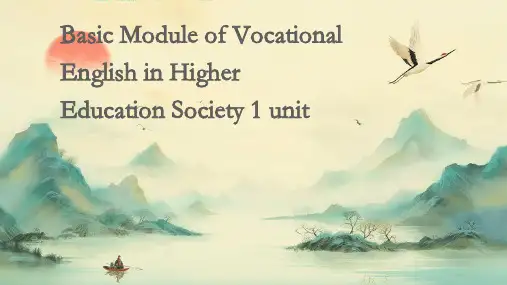
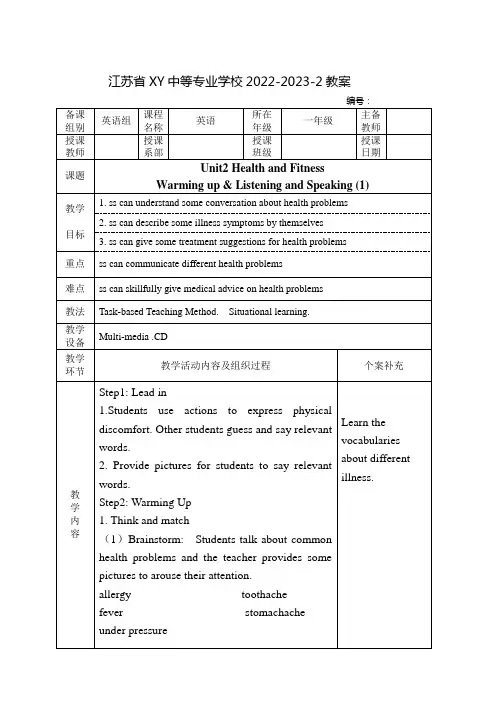
新高教版中职英语基础模块预备级u...Unit5 What’s your hobby?第一课时Teaching aims1.Knowledge aims⑴Learn the new words in this part hobby, fly, collect, music, chess, kite, fishing,stamp, favorite, be crazy about;⑵Master and use “I like…”, “I love…”to talk about one’s hobbies.2.Ability aimsListening skills--Students can understand the dialogues which talk about one’s hobbies;Speaking skills—Students can use “I like…”, “I love…”to talk about one’s ho bbies;Reading skills—Students can read the dialogues which talk about one’s hobbies;Writing skills—Students can use use “I like…”, “I love…”to write about one’s hobbies;Emotional aimsStudents know about the different cultures about asking one’s hobbies between western countries and China.The important and difficult points1.⑴Students learn and master the new words hobby, fly, collect, music, chess,kite, fishing, stamp, favorite, be crazy about;⑵Studenys learn the important sentencesI love singing.They’re my favorite.I’m crazy about Chinese songs.2. Students can use use “I like…”, “I love…”to talk about one’s hobbies; Teaching & learning methodsTask based teaching and learning;Heuristic mode of teaching;Scene teaching and learning;Cooperative learning.Teaching toolsThe multimedia and other normal teaching tools.Teaching procedureStep 1 Lead-in (10’)Free talk Ask and answer between the teacher and the students in order to lead to the new topic of the unit.T Boys and girls, although we’ve b een teacher and students for one and a half years, do you know what I like?SI don’t know.1T I doesn’t matter. I’ll tell you what I like and dislike.Look at these pictures and you’ll know what I like.(The teacher shows some pictures like singing songs, listening to music, runing, reading)T For all the things, do you know what my favorite is?(The teacher helps the students to understand “favorite”)…T All right, you’ve known what I like, and do you know what I don’t like?I don’t know.S2T Ok. Look at my actions.(The teacher shows some actionslike cooking, play football/volleball)Step 2 Presentation (5’)1.Do the activity 3, and check the answers.2.Read the dialogue in Activity 6 and learn the new words; then the teacher explainsthe sentence patternsI love singing.They ’re my favorite.I ’m crazy about Chinese songs.Step 3 Consolidation (10’)1. Students read the dialogue after the teacher several times, and then read it together.2. Ask the students to act the dialogue out in pairs.3. Ask the students to underline the sentences which talk about the abilities. Step 4 Practice (8’)Do the Activity 3 , check the answers.Step 5 Project(10’)Let the students make dialogues in pairs and act them out.For exampleS 3 What ’s your hobby, S 4?S 4 Oh, I like dancing.What about you, S 3S 3 I love running.Do you like running?S 4 No, I hate it. I ’m crazy about singing.Step 6 Summary(1’)1. Students master the new words and useful expressions.2. Students learn and master the sentence patterns which talk about one ’s hobbies. Step7 Homework(1’)1. Copy the new words and the useful expressions each three times.2. Make a dialoue according to Dialogue A.Blackboard designUnit5 What ’s your hobby?Key words sing songs.fly flying kites.collect reading.music I like collecting stamps. chess listening to music. kite shopping. fishing running.stamp。
` 课程名称 英语 3 课程代码
教 培养学生学习英语的兴趣,提高英语运用能力;了解英语国家文化,开阔 学 国际视野,更好的完善和自我发展,并具有今后在生活中和学习中运用英语的 目
标 能力。
教 学 提高学生的英语运用能力,培养良好的学习策略。并通过环环相扣的活动 重 安排,让同学们在实践中真正掌握这些策略。并做到学以致用。
点
教 尽可能将各种语言活动设置在真实的职业场景中,让学生不是在为学习英 学 语而学习英语,而是在仿真的环境中运用英语处理问题、解决问题,从而帮助 难
点 大家提高个人能力,满足工作中的实际需求,以便顺利走入未来的工作岗位。
选 用 《英语 3(基础模块)》 王笃勤 高等教育 1 版 1 次 教
材
教 学 《英语教师用书 3(基础模块)》 王笃勤 高等教育 1 版 1 次 参 《英语练习册 3(基础模块)》 王笃勤 高等教育 1 版 1 次
考 用 书
Word 文档 ` 教学 主
授 周次
教学 目的
教学 重点
教学 点
教学 手段
教学 方法
UNIT 1He Decided to 教案
have a big Christmas 核
撰写
party.
1 授 2 授 数 象
1. 言知 目 : :能 festival ,delicious ,celebrate ,prefer , share ,ghost , freeze , sigh 的意思 能用 have fun , invite ,get ready for ⋯, delicious ,dress up ,enjoy , prepare ⋯for ⋯, share ⋯with ,be covered with ,in public 介 西方
日并描述 日的 祝活 法:能 “ +to do/doing ”的 构
能区分哪些 后用“ to do ”哪些 后用“ doing ” 能用“ + to do/doing ”表达意愿、希望等意
2. 言技能目 : 听:能 西方 日名称并根据听到的信息 日 祝活 排序 :能运用“ Would you like to go to ⋯ with me? ”和 “Would you like to join us? ”等表达方式 出邀 能使用“ It sounds interesting but I prefer to ”, “I think I will. ” 等表达方式表示接受或拒 邀 :能从介 日 理的文章中提取有关 日、 日活 的信息 写:能用关 描述 的 日活 ,能 描述自己参加 日 祝的
3. 情感目 : 接受中西文化的差异,具 不同文化的包容意
能 听懂并 一些常 日活 ,掌握表达要求的 和句型。
能用关 描述 的 日活 ,能 描述自己参加 日 祝的 多媒体、磁 、 PPT 授法、 法、情境教学法
Word 文档 ` Step One Lead-in (8 mins ) 1. The teacher greets each student: Good morning. Nice to see you again. Welcome back to school. What did you do during your summer vacation? Did your family go somewhere? Did you enjoy yourselves? 2. Encourage the Ss to give answers. 3.Ask the Ss to answer what kind of holiday they like most. And collect 教 different answers on the blackboard. While collecting, teach new words such 学 as Christmas, New Year, Halloween, etc.
容 Step Two Learning vocabulary (5 mins) 及 Celebrate, delicious, dress, festival, freeze, ghost, prefer, share 教 学 Step Three Look and match (15 mins)
实 1.Reference answer: 施 1)—— a ; 2)—— d ;3)—— b ;4)—— c
过 2.Background information : 程 1)Christmas:It is a holiday observed mostly on December 25 to commemorate
the birth of Jesus, the central figure of Christianity. The date is not known to be the actual birth date of Jesus, and may have initially been chosen to correspond with either the day exactly nine months after some early Christians believed Jesus had been conceived, the date of the winter solstice on the ancient Roman calendar, or one of various ancient winter festivals. Christmas is central to the Christmas and holiday season, and in Christianity marks the beginning of the larger season of Christmastide, which lasts twelve days. 2) Thanksgiving Day: It is a harvest festival celebrated primarily in Canada and the United States. Traditionally, it is a time to give thanks for the harvest and express gratitude in general. While perhaps religious in origin, Thanksgiving is now primarily identified as a secular holiday. 3)Easter Day: It is one of the most important holidays celebrated
in Western world. Most Western holidays have a religious origin. Easter Day occurs on the first Sunday after the full moon following the spring equinox. It is originally the day to commemorate the Resurrection of Jesus Christ. And this year, Easter Monday falls on April 9. 4) Halloween : Halloween (also spelled Hallowe'en) is an annual holiday observed on October 31. It has roots in the Celtic festival of Samhain and the
Word 文档 ` Christian holiday All Saints' Day, but is today largely a secular celebration. Halloween activities include trick-or-treating, wearing costumes and attending costume parties, carving jack-o'-lanterns, ghost tours, bonfires, apple bobbing, visiting haunted attractions, pranks, telling scary stories, and watching horror films. Step Four Listening and speaking. ( 30 mins)
1. Listen and answer. 1) Which festival does Jack invite Lynn to celebrate? Halloween.
2)Does Lynn accept the invitation? Yes. 2. Listen and decide ( √ ) 1) seeing a Halloween movie
( ×) 2)telling ghost stories
( √ ) 3)dress-up dancing
教 ( ×) 4)having a feast and drinking different kinds of beer
( ×) 5)knocking at the neighbor ’ s door and asking for candies 学
3. Listen and underline 容
及 Jack: Hi, Lynn. We are planning to have a Halloween party this Thursday. 教 Would you like to join us?
学 Lynn: A Halloween party? It sounds interesting but I prefer to stay at home. 实
施 Jack: Why? You will have a lot of fun if you join us. 过 Lynn: Maybe you are right, but I had no fun at my last Halloween party. It
程 was terrible.
Jack : What happened? Lynn: You can imagine how I felt when I saw that everyone had dressed up except me. Jack : That ’ s not a big deal. I ’ ll help you get ready for this Halloween party.